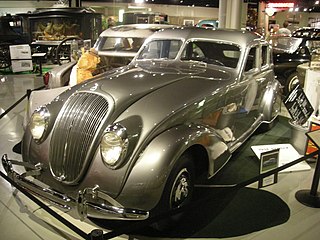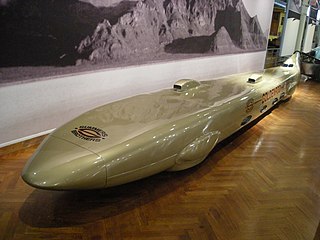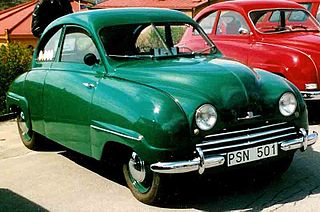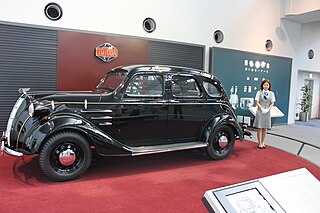 W
WThe Auto Union Grand Prix racing cars types A to D were developed and built by a specialist racing department of Auto Union's Horch works in Zwickau, Germany, between 1933 and 1939.
 W
WThe Bendix SWC is a one-of-a-kind, hand-built prototype concept car built in 1934. It is a four-door, five-passenger sedan that was designed by Alfred Ney of the Bendix Corporation in South Bend, Indiana. Although considered a proof-of-concept vehicle rather than a true prototype for future production, the Bendix SWC is regarded as ahead of its time because of its innovative features, incorporating front-wheel drive, four-wheel hydraulic brakes with open drums for better cooling, and four-wheel independent suspension that used A-arms mounted in rubber blocks in place of conventional springs. The styling was similar to other examples of automotive streamlining such as the contemporary DeSoto Airflow and Chrysler Airflow.
 W
WBlue Flame is a rocket-powered land speed racing vehicle that was driven by Gary Gabelich and achieved the world land speed record on Bonneville Salt Flats in Utah on October 23, 1970. The vehicle set the FIA world record for the flying mile at 622.407 mph (1,001.667 km/h) and the flying kilometer at 630.388 mph (1,014.511 km/h).
 W
WThe Chrysler Airflow is a full-size car produced by Chrysler from 1934 to 1937. The Airflow was the first full-size American production car to use streamlining as a basis for building a sleeker automobile, one less susceptible to air resistance. Chrysler made a significant effort at a fundamental change in automotive design with the Chrysler Airflow, but it was ultimately a commercial failure.
 W
WThe Fiat 1500 was a six-cylinder car produced by the Fiat from 1935 to 1950. It was one of the first cars tested in a wind tunnel, following the Chrysler Airflow produced one year earlier. The streamlined styling achieved an aerodynamic efficiency unequalled before it in a touring car and disproved the thesis aerodynamic cars would not sell.
 W
WGoldenrod is an American streamliner land speed racing car which held the wheel-driven land speed record from 1965 to 1991. It was owned by Bob "Butch" and Bill Summers, of Ontario, California. Bob Summers drove the car to set the land speed record. The car is powered by four fuel injected Chrysler Hemi engines mounted inline and created a total output of 2,400 hp (1,800 kW). The car was originally built in Southern California and the team included James Crosby.
 W
WThe International Metro Van, made by International Harvester, is a step van, also known as walk-in or multi-stop delivery truck. This vehicle type was one of the earlier, mass-produced forward control vehicles, once commonly used for milk or bakery delivery, as well as ambulance services, mobile offices, and radio transmitter vans. Typically, they were 1/2-, 3/4-, or 1-ton panel trucks that allowed the driver to stand or sit while driving the vehicle.
 W
WThe JCB Dieselmax is a diesel-engined 'streamliner' car designed for the purpose of breaking the land speed record for a diesel-engined vehicle.
 W
WThe Lincoln-Zephyr is a line of luxury cars that was produced by the Lincoln division of Ford from 1936 to 1942. Bridging the gap between the Ford V8 DeLuxe and the Lincoln Model K, the Lincoln-Zephyr expanded Lincoln to a second model line, competing against the Chrysler Airstream, LaSalle, and the Packard One-Twenty.
 W
WThe Saab 92 was the first production car from Saab. The design was very aerodynamic for its time, with a drag coefficient of 0.30. The entire body was stamped out of one piece of sheet metal and then cut to accommodate doors and windows. Full-scale production started December 12, 1949, based on the prototype Ursaab. All of them were of the Deluxe version. A standard version was advertised, but nobody was interested in buying it so no standard versions were produced.
 W
WSpeed Demon is a land speed racing car built in 2010 by Ron Haim for George Poteet.
 W
WStreamline Cars Ltd was the company responsible for making the Burney car designed by Dennis Burney.
 W
WThe Czechoslovakian Tatra 77 (T77) is by many considered to be the first serial-produced, truly aerodynamically-designed automobile. It was developed by Hans Ledwinka and Paul Jaray, the Zeppelin aerodynamic engineer. Launched in 1934, the Tatra 77 is a coach-built automobile, constructed on a platform chassis with a pressed box-section steel backbone rather than Tatra's trademark tubular chassis, and is powered by a 60 horsepower (45 kW) rear-mounted 2.97-litre air-cooled V8 engine, in later series increased to a 75 horsepower (56 kW) 3.4-litre engine. It possessed advanced engineering features, such as overhead valves, hemispherical combustion chambers, a dry sump, fully independent suspension, rear swing axles and extensive use of lightweight magnesium alloy for the engine, transmission, suspension and body. The average drag coefficient of a 1:5 model of Tatra 77 was recorded as 0.2455. The later model T77a has a top speed of over 150 km/h (93 mph) due to its advanced aerodynamic design which delivers an exceptionally low drag coefficient of 0.212, although some sources claim that this is the coefficient of a 1:5 scale model, not of the car itself.
 W
WThrustSSC, Thrust SSC or Thrust supersonic car is a British jet car developed by Richard Noble, Glynne Bowsher, Ron Ayers, and Jeremy Bliss.
 W
WThe A1 was the first prototype passenger car built by the company that became Toyota. It was redesigned and put into production as Toyota's first production cars, the AA sedan and the AB cabriolet. These were succeeded by the similar AE, AC and BA sedans.